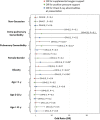Markers for severe disease and long-term sequelae in pediatric patients with severe acute respiratory syndrome coronavirus 2 infection
- PMID: 35522823
- PMCID: PMC9115526
- DOI: 10.1111/ped.15177
Markers for severe disease and long-term sequelae in pediatric patients with severe acute respiratory syndrome coronavirus 2 infection
Abstract
Background: Coronavirus disease 2019 (COVID-19) is caused by severe acute respiratory syndrome coronavirus 2 (SARS-CoV-2) and has resulted in substantial global morbidity and mortality since late 2019. Children can be infected but the disease predominantly affects adults, and research into the acute and chronic sequelae mostly pertains to this population. This study determines the clinical and demographic parameters associated with severe acute disease and chronic complications from COVID-19 in the pediatric population.
Methods: A retrospective chart review was undertaken of all patients between birth and 21 years of age who were positive for SARS-CoV-2 by polymerase chain reaction (PCR) and were admitted to two tertiary care hospitals between March 1, 2020, and January 21, 2021. Markers for severe disease were defined as supplemental oxygen requirement, positive pressure ventilation, and acute chest radiograph abnormality at presentation. Chronic disease was defined as symptoms persisting >4 weeks.
Results: Review of 101 patients with positive SARS-CoV2 testing found 67 presentations consistent with acute symptomatic infection. Age distribution was bimodal, with predominance in infancy and adolescence. Most (75%) had an extrapulmonary comorbidity, and fewer patients (33%) had pre-existing lung disease. A history of pulmonary comorbidity and obesity was significantly associated with markers for severe disease. Long-term chronic complications were associated with history of underlying lung disease and acute severe COVID-19.
Conclusions: Demographic and clinical markers were associated with severe COVID-19 in children. Moreover, both the presence of pulmonary comorbidity and severe acute COVID-19 are associated with long-term sequelae.
Keywords: pediatric COVID-19.
© 2022 Japan Pediatric Society.
Figures
References
-
- Pediatric AAo. Available from https://wwwaaporg/en/pages/2019‐novel‐coronavirus‐covid‐19‐infections/ch.... Accessed on 19 Jan 2012.
-
- George PM, Barratt SL, Condliffe R et al. Respiratory follow‐up of patients with COVID‐19 pneumonia. Thorax 2020; 75: 1009–16. - PubMed
MeSH terms
Substances
LinkOut - more resources
Full Text Sources
Medical
Miscellaneous



